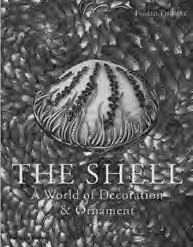Ingrid Thomas. Publisher Thames and Hudson 2007, ISBN 978-O-500-51357-.6. A4 Hardback 256 pages £35
Kevin Brown in Mollusc World 15. Pg 22.
 The aesthetic appeal of shells is such that few people can resist picking them up off a beach. This appeal transcends cultural, racial, religious and age differences world-wide. Shells have been used for millennia both as artifacts in themselves and in decorative work, and have inspired artists working in many different materials; precious metals, ceramics, wood, glass, textiles, paint, and even plastic. The result is a rich legacy of artifacts, some weird some wonderful, some simple some ornate, some beautiful some grotesque, but all made from or inspired by shells.
The aesthetic appeal of shells is such that few people can resist picking them up off a beach. This appeal transcends cultural, racial, religious and age differences world-wide. Shells have been used for millennia both as artifacts in themselves and in decorative work, and have inspired artists working in many different materials; precious metals, ceramics, wood, glass, textiles, paint, and even plastic. The result is a rich legacy of artifacts, some weird some wonderful, some simple some ornate, some beautiful some grotesque, but all made from or inspired by shells.
In this book the author, a member of the Conchological Society, has brought together a selection of these objects drawn from public and private collections around the world and produced by many different cultures. These include objects from the Americas, Oceania, India, China, Korea, Japan, Africa and Europe, dating from between 28,000 BC to 2,005 AD, all showing how universal the influence of shells has been.
The book is lavishly illustrated with over 500 high quality full colour photographs. Some of the items shown may be too stylized to appeal to pure shell collectors, though these show how designers have taken basic ideas or motifs and ‘run with them’. While a few items may seem over familiar (it would be almost impossible to cover the subject without mentioning Boticelli’s “The birth of Venus” or Rembrandt’s reversed Conus marmoreus) the vast majority will be unfamiliar or even revelatory.
It would be a mistake thou to regard this as just a picture book, for woven around the illustrations, and closely relating to them, is a clear informative yet readable text which has obviously been well researched over a long period. Main chapters cover; Carved Shells, Shell Jewelry, Shells in Art, Ornamental Shellwork, Shells in Architecture and Shells in the Decorative Arts, but the book covers far more, and. I’m sure that, like me, even hardened shell buffs will learn from and be inspired by this book.
The book has an illustrated glossary showing the shells mentioned in their natural state, useful to those coming to this from the art world but unfamiliar with shells. Also aimed at the non-collector are brief sections on the classification and naming of shells, conchology - the collection and study of shells, and shell collecting and conservation today. There is a good bibliography and list of recommended websites, also details of museums worldwide with shell collections and of shell houses and grottoes open to the public.
My main criticism of the book would be that it almost entirely deals with marine shells, though I believe this was the publishers remit. Even with that limitation the author must have had a difficult task in deciding what to include and what to exclude while maintaining a balance between different cultures, different mediums of artwork and different periods of history.
This book is destined to be a classic in the conchological ouvre, and will appeal to people in many fields outside conchology. It is highly recommended, and at £35 is very modestly priced.
Editors note: Those of you with access to the web will find that this book is available from £22 - £35 (plus packing and postage) from different online bookshops advertising through Amazon.
